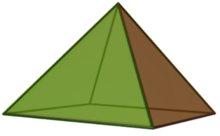Johnson solid
Appearance
English
[edit]
Etymology
[edit]From Johnson (“a surname”) + solid, after American mathematician Norman Johnson, who listed them in 1966.
Noun
[edit]Johnson solid (plural Johnson solids)
- (geometry) Any of a class of convex polyhedra that have regular faces but are not uniform (that is, not Platonic solids, Archimedean solids, prisms, or antiprisms).
- 1986 April, Andrew Hume, Folding Regular Polyhedra, AUUGN: Australian Unix Users Group Newsletter, Volume 6, Number 5, page 40,
- The Johnson solids, combined with the Archimedean polyhedra and five of the regular polyhedra, constitute all the possible convex polyhedra with regular faces.[Excluding the two infinite classes described below (prisms and antiprisms).]
- 2003, Rona Gurkewitz, Bennett Arnstein, Multimodular Origami Polyhedra: Archimedeans, Buckyballs and Duality, page 2:
- There are other possible models that we have not written about and for which we do not include pictures. namely the Johnson solids and their truncations [2]. (The egg[truncated hexadecahedron] is an approximation of a truncation of a Johnson solid.)
- 2012, Thomas Hull, Project Origami: Activities for Exploring Mathematics, 2nd edition, page 159:
- Students will be very unlikely to discover very many of the Johnson solids on their own. Someone may come up with the triangular and pentagonal dipyramids, but the others are just not very intuitive. Once students are convinced that there are no other possibilities than the ones they've come up with, then it is time to unveil some of the more complicated Johnson solids.
- 1986 April, Andrew Hume, Folding Regular Polyhedra, AUUGN: Australian Unix Users Group Newsletter, Volume 6, Number 5, page 40,
Synonyms
[edit]- (convex non-uniform polyhedron that has regular faces): Johnson polyhedron
Translations
[edit]convex non-uniform polyhedron that has regular faces
|
Further reading
[edit] Johnson solid on Wikipedia.Wikipedia
Johnson solid on Wikipedia.Wikipedia  List of Johnson solids on Wikipedia.Wikipedia
List of Johnson solids on Wikipedia.Wikipedia
